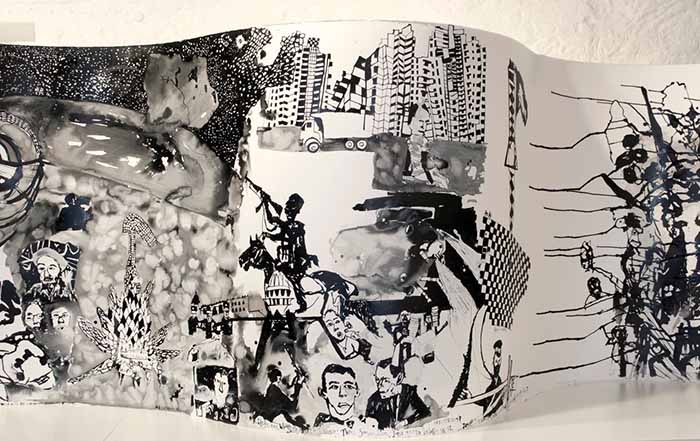
As I write this review, Australia is on High Terrorist alert, a terrorist plot has apparently been foiled, new laws threaten to reduce freedoms and Tony Abbott has just sent troops to the Middle East to combat ISIS. As this large political and military machine rolls onwards the public, who democratically elected their leaders, seem to have little say in these life-shattering decisions. Yet inside the large, darkened Long Gallery, there are clamorous voices, saying 'no' and 'why?' and 'why not?' and 'have you thought about this?' and 'did you realise?'. Giving Voice: The Art of Dissent is an exhibition of activist art curated by Yvonne Rees-Pagh.
The voice of Locust Jones is the first image of the show. The artist's passionately inked words on paper yell GLOBAL SECURITY ALERT, SYSTEMIC CORRUPTION, MONEY IS THE ENEMY. Paired with this, running the entire width of the gallery, is his continuous work on paper Everyday Atrocities. This collage of inked visual imagery documents the barrage of daily news that evoked a response within the artist - a kind of drawn, emotional litmus.
The soundtrack of Cigdem Aydemir’s work Bombshell, while not immediately apparent, underscores a reading of the entire show. The video depicts a woman in a burqa, storm clouds gathering behind, her robes flying in a playful interpretation of Marilyn Monroe’s quintessential air vent moment in the movie The Seven Year Itch. The soundtrack, which the artist statement describes as '... thunder (or distant bombs)", establishes an ominous atmosphere. Just as Monroe’s moment presented her as sex bomb, this frames a woman contained and controlled. Even the strength of the airflow does not reveal anything of her body beyond the outline of hand and ankle. Provocatively, the Monroe connection may also gesture to an irrepressible sexual woman hidden beneath this controversial garment.
If Bombshell sets the aural tone, it is James Barker’s Lest I forget that packs the emotional punch. Life-sized, swaddled bodies are stacked to the ceiling on a narrow white bed. Cast white feet of all ages protrude from their wraps, including those of a tiny child. Shockingly, a life-scaled representation of the artist sleeps beneath this horrific pile, his face is spot-lit in the gallery gloom. The work suggests the shameful effect of being washed by the news like the tide, one terrible image of death dissolving another. We forget these swaddled bodies, over a downed plane or a giant flood. Here the artist makes concrete his desire to not forget.
This is a provocative, powerful and carefully curated show. Each work tows with it a weighty story of personal significance for each artist. It could be argued that artists do not figure within the conversation that decides upon the shape of the world we live in and yet each of these artists still calls out. As Pete Hay describes in his catalogue essay, history has shown that democracy within the system is an unattainable ideal and that it is only through activism that people can truly have a voice. Through the medium of sculpture, painting, printmaking, film, these activist artists transform incessant news back into stories of real events, real people, real pain.












